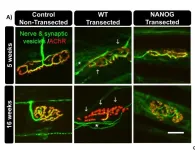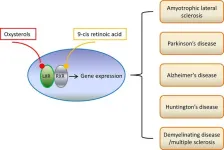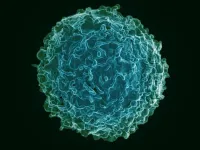(Press-News.org) Scientists from Cleveland Clinic and Cornell University have designed a publicly-available software and web database to break down barriers to identifying key protein-protein interactions to treat with medication.
The computational tool is called PIONEER (Protein-protein InteractiOn iNtErfacE pRediction). Researchers demonstrated PIONEER’s utility by identifying potential drug targets for dozens of cancers and other complex diseases in a recently published Nature Biotechnology article.
Genomic research is key in drug discovery, but it is not always enough on its own, says Feixiong Cheng, PhD, study co-lead author and director of Cleveland Clinic’s Genome Center. When it comes to making medications based on genomic data, the average time between discovering a disease-causing gene and entering clinical trials is 10-15 years.
“In theory, making new medicines based on genetic data is straightforward: mutated genes make mutated proteins,” Dr. Cheng says. “We try to create molecules that stop these proteins from disrupting critical biological processes by blocking them from interacting with healthy proteins, but in reality, that is much easier said than done.”
One protein in our body can interact with hundreds of other proteins in many different ways. Those proteins can then interact with hundreds more, forming a complex network of protein-protein interactions called the interactome, Dr. Cheng explains. This becomes even more complicated when disease-causing DNA mutations are introduced into the mix. Some genes can be mutated in many ways to cause the same disease, meaning one condition can be associated with many interactomes arising from just one differently mutated protein.
Drug developers are left with tens of thousands of potential disease-causing interactions to pick from – and that’s only after they generate the list based on the affected protein’s physical structures.
Dr. Cheng sought to make an artificial intelligence (AI) tool to help genetic/genomic researchers and drug developers identify the most promising protein-protein interactions more easily, teaming up with Haiyuan Yu, PhD, director of the Cornell University Center for Innovative Proteomics. The group integrated massive amounts of data from multiple sources including:
Genomic sequences from almost 100,000 individuals who were either born with disease-causing mutations or acquired them later in life (usually cancer).
Physical three-dimensional structures of over 16,000 human proteins, and data on how DNA mutations impact those structures.
Known interactions between almost 300,000 different protein-protein pairs.
Their resulting database allows researchers to navigate the interactome for more than 10,500 diseases, from alopecia to von Willebrand Disease.
Researchers who identified a disease-associated mutation can input it into PIONEER to receive a ranked list of protein-protein interactions that contribute to the disease and can potentially be treated with a drug. Scientists can search for a disease by name to receive a list of potential disease-causing protein interactions that they can then go on to research. PIONEER is designed to help biomedical researchers who specialize in almost any disease across categories including autoimmune, cancer, cardiovascular, metabolic, neurological and pulmonary.
The team validated their database's predictions in the lab, where they made almost 3,000 mutations on over 1,000 proteins and tested their impact on almost 7,000 protein-protein interaction pairs. Preliminary research based on these findings is already underway to develop and test treatments for lung and endometrial cancers. The team also demonstrated that their model’s protein-protein interaction mutations can predict:
Survival rates and prognoses for various cancer types, including sarcoma, a rare but potentially deadly cancer.
Anti-cancer drug responses in large pharmacogenomics databases.
The researchers also experimentally validated that protein-protein interaction mutations between the proteins NRF2 and KEAP1 can predict tumor growth in lung cancer, offering a novel target for targeted cancer therapeutic development.
“The resources needed to conduct interactome studies poses a significant barrier to entry for most genetic researchers,” says Dr. Cheng. “We hope PIONEER can overcome these barriers computationally to lessen the burden and grant more scientists with the ability to advance new therapies.”
About this study:
This study has five co-first authors who contributed equally: Dapeng Xiong, PhD (Cornell University); Yunguang Qiu, PhD (Cleveland Clinic); Junfei Zhao, PhD (Columbia University); Yadi Zhou, PhD (Cleveland Clinic); and Dongjin Lee, PhD (Cornell University).
It was funded in part by The National Institute on Aging (R01AG084250, R56AG074001, U01AG073323, R01AG066707, R01AG076448, R01AG082118, RF1AG082211, and R21AG083003) and The National Institute of Neurological Disorders and Stroke (RF1NS133812).
The work was also supported in part by the late Charis Eng, MD, PhD, the Sondra J. and Stephen R. Hardis Chair of Cancer Genomic Medicine at Cleveland Clinic. Dr. Cheng wishes to dedicate this paper to the memory of Dr. Eng, founding Chair of Genomic Medicine Institute. She will be remembered for her lifelong dedication to human genetics, personalized genomic healthcare research and mentorship.
END
New AI tool predicts protein-protein interaction mutations in hundreds of diseases
Tool predicts how one DNA mutation influences human protein-protein interactome, supporting disease diagnosis and drug discovery using innovative AI technologies
2024-10-24
ELSE PRESS RELEASES FROM THIS DATE:
Gene named for mythical Irish land could aid muscle function after traumatic nerve injuries
2024-10-24
BUFFALO, N.Y. — The key to recovering from traumatic nerve injuries, like those sustained in motor vehicle accidents or gunshot wounds, may be a gene named for the land of everlasting youth in Irish folklore.
In a study published today (Oct. 24) in Nature Communications, a University at Buffalo-led research team describes how the gene, called NANOG, can improve the regrowth of damaged nerves and re-establish innervation (the process of nerves growing and connecting with organs or tissues) after traumatic severing of peripheral nerves.
The gene’s name is derived from Tír na nÓg, which is a mythical ...
Virginia Tech team creates new method of flexing on electronics
2024-10-24
If a phone or other electronic device was made of soft materials, how would that change its use? Would it be more durable? If hospital health monitoring equipment was made of less rigid components, would it make it easier for patients to wear?
While electronics of that type may still be far in the future, Virginia Tech researchers have developed an innovative method for constructing the soft electronic components that make them up. The focus of a project from the team of Michael Bartlett, principal investigator and associate professor in the Department of Mechanical Engineering, ...
$79 billion - the hidden climate costs of U.S. materials production
2024-10-24
A study published today in IOP Publishing’s journal Environmental Research Letters, has revealed a staggering $79 billion in annual climate-related costs from the production of common materials in the United States. These costs, which stem from greenhouse gas emissions, are not reflected in current market prices, effectively creating a massive subsidy for carbon-intensive industries.
“High price point is a common reason why low emission alternative materials are not adopted voluntarily by industries. Accounting for the externalized cost of emissions could provide an economic basis for driving innovation and implementation of alternative material production ...
Breakthrough review links hormone receptors to age-related brain disease prevention
2024-10-24
Houston, Texas – In a comprehensive review published in the October 2024 issue of Genomic Psychiatry, researchers have unveiled crucial insights into how two types of hormone receptors collaborate to maintain brain health and potentially prevent neurodegenerative diseases.
The study, led by Professor Jan-Åke Gustafsson and colleagues at the University of Houston and Karolinska Institutet, demonstrates that liver X receptors (LXRs) and thyroid hormone receptors (TRs) work together in a previously unrecognized manner to regulate critical brain functions and protect ...
New West Health-Gallup survey finds desire for better access to mental healthcare is nonpartisan issue
2024-10-24
WASHINGTON, D.C. — OCTOBER 24, 2024 — Roughly four in five Americans say they either strongly (48%) or somewhat (31%) support a federal law that requires insurance companies to cover mental health at the same level they do medical or surgical care, including 95% of Democrats, 79% of independents and 67% of Republicans. Despite the widespread support, half of Americans (50%) have little to no trust that health insurers will comply with the law, according to a new West Health-Gallup survey released today.
In 2020, less than half of all adults with mental illness received treatment, according to the White House, leading the Biden ...
Cancer prevalence across vertebrate species decreases with gestation time, may increase with adult mass
2024-10-24
PHILADELPHIA – Cancer prevalence rates varied widely across vertebrate species and generally increased with higher adult mass and decreased with longer gestation time, according to results published in Cancer Discovery, a journal of the American Association for Cancer Research (AACR).
In 1977, Sir Richard Peto, FRS, FAACR, hypothesized that cancer prevalence in animals should correlate linearly with body size and lifespan, as larger animals have more cells in which to accumulate damage, and long-lived animals have more time to acquire mutations. He observed, however, that this did not seem to be the case based on ...
Epic voyage to uncover what causes tsunamis
2024-10-24
A team of international scientists, including two researchers from The Australian National University (ANU), will soon sail to the Japan Trench to discover more about what causes tsunamis.
The researchers will be on board the world’s most advanced drilling-equipped science vessel, Chikyu. It will drill directly into the Tōhoku-oki earthquake fault zone, where one of the most powerful earthquakes ever recorded in Japan occurred in 2011.
The stress accumulated at this junction over hundreds of years was suddenly released, causing the tectonic plate on which Japan sits to skip upwards and eastwards by up to 50 metres. This shallow slip displaced a vast area ...
USC Stem Cell mouse study sheds light on the secret to maintaining a youthful immune system
2024-10-24
What keeps some immune systems youthful and effective in warding off age-related diseases? In a new paper published in Cellular & Molecular Immunology, USC Stem Cell scientist Rong Lu and her collaborators point the finger at a small subset of blood stem cells, which make an outsized contribution to maintaining either a youthful balance or an age-related imbalance of the two main types of immune cells: innate and adaptive.
Innate immune cells serve as the body’s first line of defense, mobilizing a quick and general attack against invading germs. For germs that evade the body’s innate immune defenses, the second line of attack consists of adaptive immune ...
Suicide risk highest on Mondays and New Year’s Day
2024-10-23
Suicide risk is highest on Mondays and increased on New Year’s Day, whereas suicide risk on weekends and Christmas varies by country and region, finds an analysis of data from 26 countries published by The BMJ today.
The researchers say their results can help to better understand the short term variations in suicide risks and define suicide prevention action plans and awareness campaigns.
According to the World Health Organization, more than 700,000 people died due to suicide in 2019, accounting for approximately 1.3% of deaths, which was higher than the number of deaths by malaria, HIV/AIDS, and breast cancer.
Previous studies have shown that suicide ...
Gene signature shows promise to improve survival for breast cancer patients
2024-10-23
Using a gene signature technique to tailor chemotherapy for patients with early triple negative breast cancer shows promise as a way to improve disease-free survival, finds a clinical trial published by The BMJ today.
Triple negative breast cancer is an aggressive type of breast cancer that carries a higher risk of recurrence and death after standard treatment. As such, there is an urgent need for more effective chemotherapy strategies.
Multigene signatures are tests that analyse genes in a tumour sample to predict how well ...
LAST 30 PRESS RELEASES:
Common brain parasite can infect your immune cells. Here's why that's probably OK
International experts connect infections and aging through cellular senescence
An AI–DFT integrated framework accelerates materials discovery and design
Twist to reshape, shift to transform: Bilayer structure enables multifunctional imaging
CUNY Graduate Center and its academic partners awarded more than $1M by Google.org to advance statewide AI education through the Empire AI consortium
Mount Sinai Health system receives $8.5 million NIH grant renewal to advance research on long-term outcomes in children with congenital heart disease
Researchers develop treatment for advanced prostate cancer that could eliminate severe side effects
Keck Medicine of USC names Christian Pass chief financial officer
Inflatable fabric robotic arm picks apples
MD Anderson and SOPHiA GENETICS announce strategic collaboration to accelerate AI-driven precision oncology
Oil residues can travel over 5,000 miles on ocean debris, study finds
Korea University researchers discover that cholesterol-lowering drug can overcome chemotherapy resistance in triple-negative breast cancer
Ushikuvirus: A newly discovered giant virus may offer clues to the origin of life
Boosting the cell’s own cleanup
Movement matters: Light activity led to better survival in diabetes, heart, kidney disease
Method developed to identify best treatment combinations for glioblastoma based on unique cellular targets
Self-guided behavioral app helps children with epilepsy sleep earlier
Higher consumption of food preservatives is associated with an increased risk of type 2 diabetes
NTU Singapore-led team captures first-ever ‘twitch’ of the eye’s night-vision cells as they detect light, paving the way for earlier detection of blindness-causing diseases
Global aviation emissions could be halved through maximising efficiency gains, new study shows
Fewer layovers, better-connected airports, more firm growth
Exposure to natural light improves metabolic health
As we age, immune cells protect the spinal cord
New expert guidance urges caution before surgery for patients with treatment-resistant constipation
Solar hydrogen can now be produced efficiently without the scarce metal platinum
Sleeping in on weekends may help boost teens’ mental health
Study: Teens use cellphones for an hour a day at school
After more than two years of war, Palestinian children are hungry, denied education and “like the living dead”
The untold story of life with Prader-Willi syndrome - according to the siblings who live it
How the parasite that ‘gave up sex’ found more hosts – and why its victory won’t last
[Press-News.org] New AI tool predicts protein-protein interaction mutations in hundreds of diseasesTool predicts how one DNA mutation influences human protein-protein interactome, supporting disease diagnosis and drug discovery using innovative AI technologies






